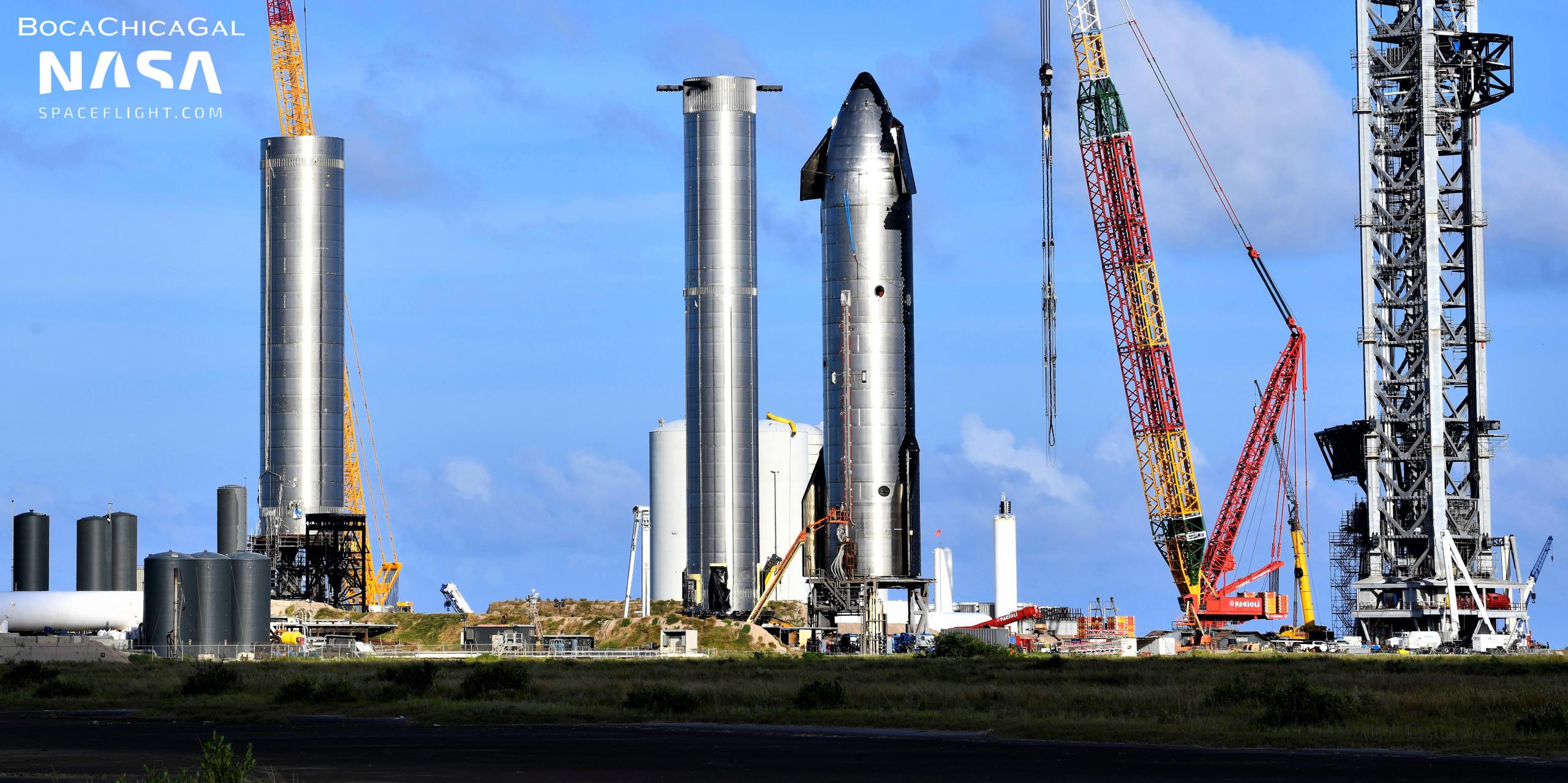
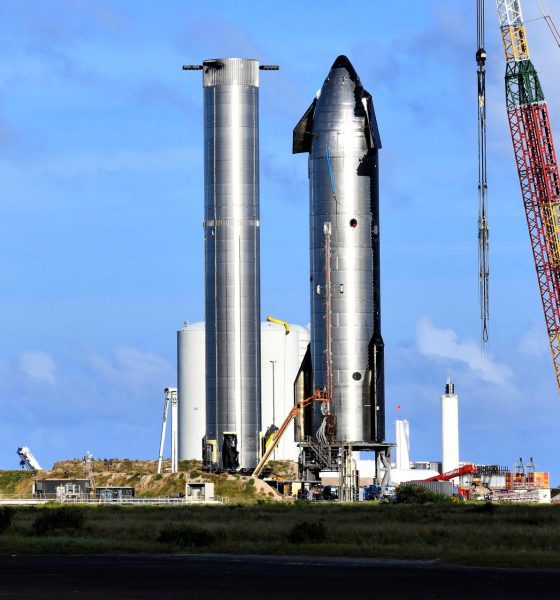
News
SpaceX working on several Starship, Super Heavy upgrades and design changes
Not long after Elon Musk confirmed plans to add three more Raptor engines to Starship and stretch the upper stage’s propellant tanks, the SpaceX CEO has confirmed one of several smaller design changes planned in the interim.
On January 3rd, Musk confirmed that SpaceX is entirely relocating one of two secondary ‘header’ tanks that Starships use to store landing propellant. A graphic sketched on the side of future Starship rings further revealed plans to tweak most of the subsections that SpaceX stacks to form a Starship, complementing an upgraded nosecone design. Finally, another design change was spotted on hardware that will eventually become part of the first full-thrust Super Heavy booster.
According to Musk, starting with Starship 24 (S24), which is likely the next ship SpaceX will complete, the methane (fuel) header tank will be relocated from Starship’s common dome to its nosecone. From the start, Starship’s oxygen header tank has been located in the very tip of the nose – placed in such an inconvenient location for the sole purpose of shifting Starship’s center of gravity forward. Now, the methane header tank will join it in the nose, with the obvious explanation being a need to shift that center of gravity even further forward. It’s possible that this change was planned before SpaceX realized the performance benefits of a stretched, nine-engine Starship, but it could also be a preemptive modification meant to counteract the added weight of three more Raptor engines and longer tanks.
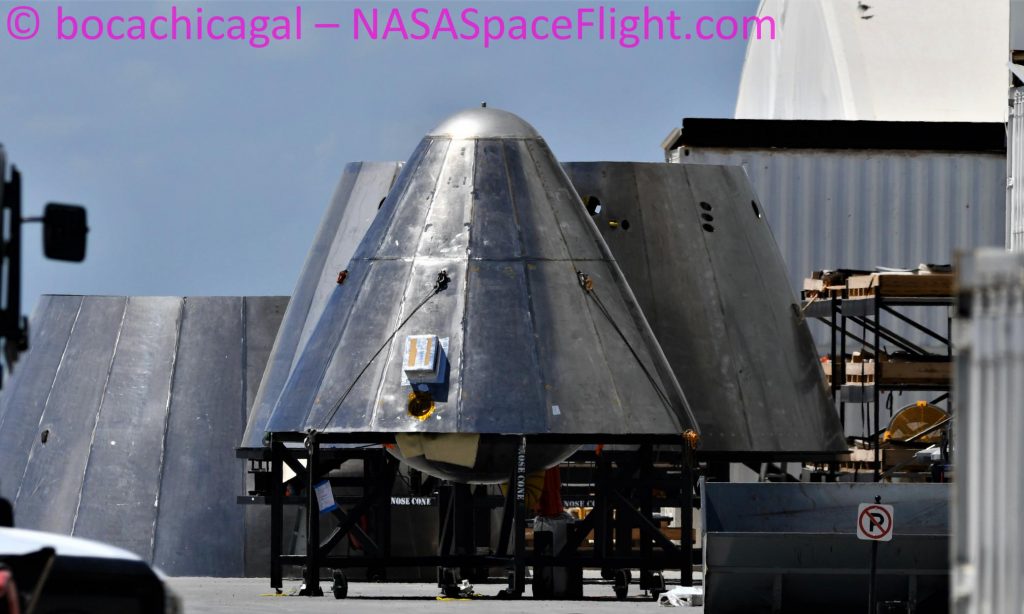
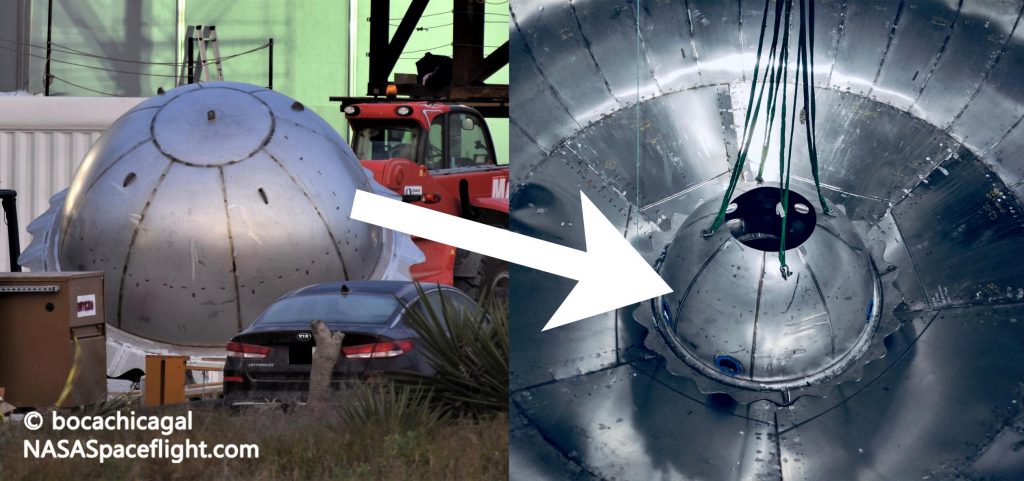
Musk’s confirmation of the methane header tank’s relocation came just a few days after a drawing on the side of a Starship section further confirmed several more minor design changes. Starbase ‘hieroglyphics’ are not uncommon, as SpaceX engineers and technicians have often used hardware itself as a sort of whiteboard to sketch out plans and literally annotate ongoing work. This particular drawing was exceptionally detailed and useful, effectively showing exactly how Starship’s design will change beginning with Ship 24. The changes are simple enough: in essence, SpaceX will be adding an extra ring to several Starship ‘sections.’ For current ships, six distinct sections are stacked to form the Starship’s cylindrical tankage and hull.
It takes another five stacked sections to complete the current nosecone design. Counting the nose as one, it takes about seven stack operations to fully assemble the basic structure of a Starship. With the design changes sketched out on a Starship S24 ring and an upgraded nosecone that will debut on the same ship, fully assembling a nosecone will now take two or three stacks (down from five) and fully assembling a Starship will take six stacks (down from seven). While obviously not a major redesign, the changes will significantly simplify (and thus potentially speed up) Starship assembly, which will have additional positive follow-on impacts on plumbing, wiring, and heat shield installation.
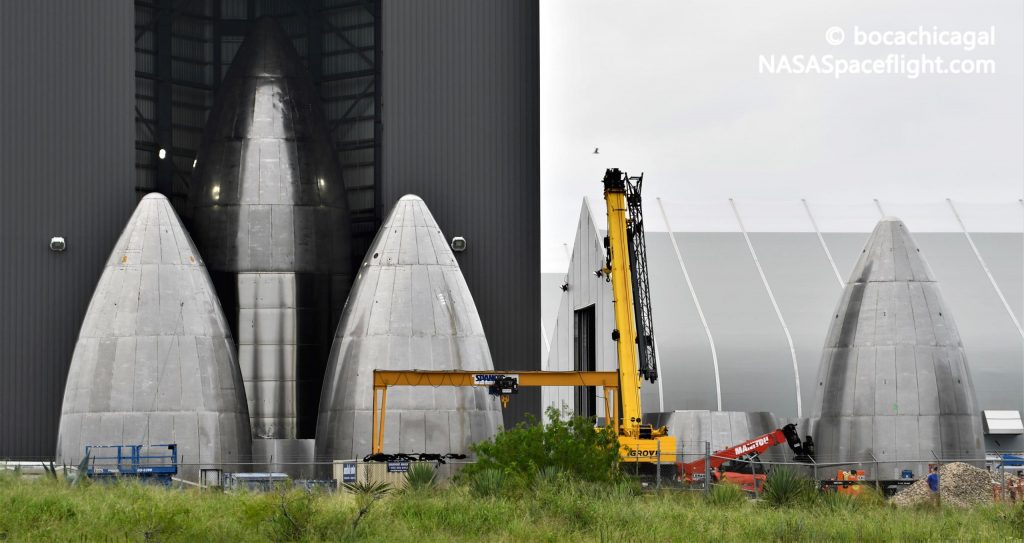
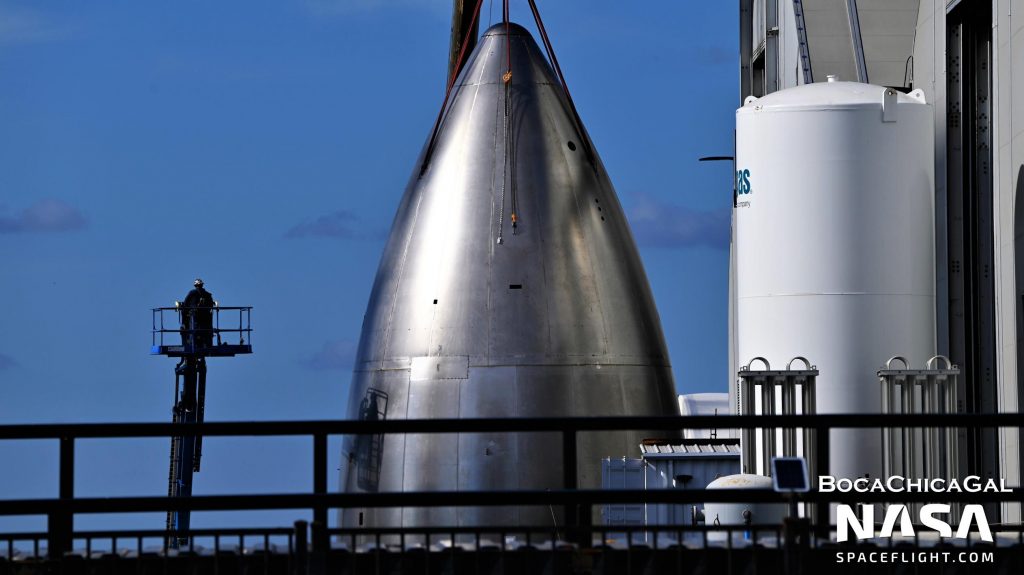
There’s good reason to believe that some of the changes – especially expanding Starship’s nose barrel from four to five rings tall – will end up being applied to Super Heavy, potentially reducing the number of booster ‘sections’ needed from nine to seven or eight. However, there are already signs of some weirder changes being made to Super Heavy’s design. On December 21st, a Super Heavy thrust dome – likely Booster 7’s – was sleeved with several steel rings as part of a now-routine process, partially completing the first 33-engine thrust section. However, instead of the usual aft barrel section comprised of three six-foot-tall (~1.82m) steel rings, this ‘sleeve’ was made up of four ~1.4m-tall rings – the first time in Starbase history that shorter rings have appeared on any hardware.
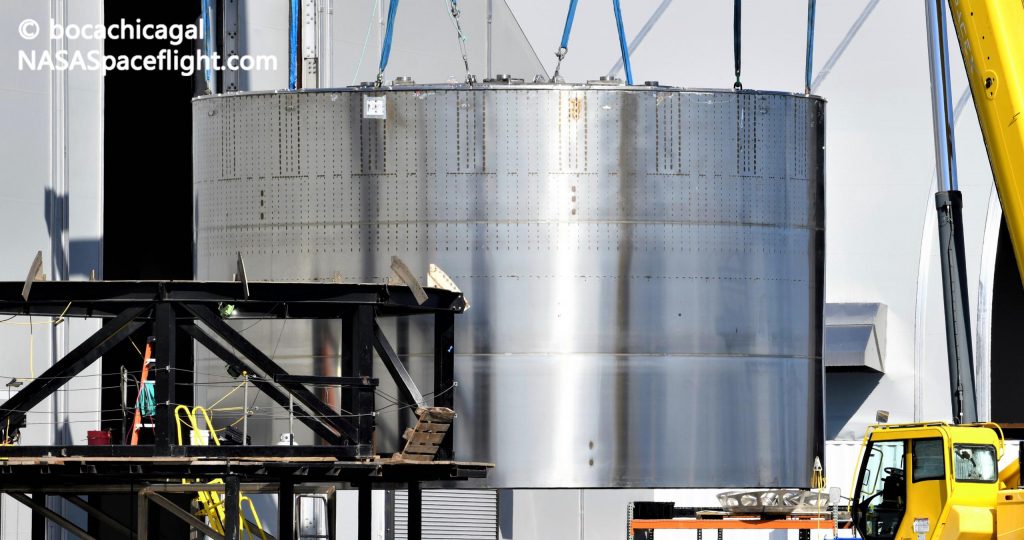
Unlike all the other changes described above, it’s entirely unclear what benefit SpaceX is getting from keeping a given ship or booster section the same height while adding more smaller rings to it – a process that will inherently increase the complexity and amount of work required to complete that section. Regardless, it’s clear that SpaceX is in the midst of a significant period of design revision that could see Ship 24 and Booster 7 debut with a wide range of upgrades and design changes in just a few months.

News
Tesla FSD fleet is nearing 7 billion total miles, including 2.5 billion city miles
As can be seen on Tesla’s official FSD webpage, vehicles equipped with the system have now navigated over 6.99 billion miles.

Tesla’s Full Self-Driving (Supervised) fleet is closing in on almost 7 billion total miles driven, as per data posted by the company on its official FSD webpage.
These figures hint at the massive scale of data fueling Tesla’s rapid FSD improvements, which have been quite notable as of late.
FSD mileage milestones
As can be seen on Tesla’s official FSD webpage, vehicles equipped with the system have now navigated over 6.99 billion miles. Tesla owner and avid FSD tester Whole Mars Catalog also shared a screenshot indicating that from the nearly 7 billion miles traveled by the FSD fleet, more than 2.5 billion miles were driven inside cities.
City miles are particularly valuable for complex urban scenarios like unprotected turns, pedestrian interactions, and traffic lights. This is also the difference-maker for FSD, as only complex solutions, such as Waymo’s self-driving taxis, operate similarly on inner-city streets. And even then, incidents such as the San Francisco blackouts have proven challenging for sensor-rich vehicles like Waymos.
Tesla’s data edge
Tesla has a number of advantages in the autonomous vehicle sector, one of which is the size of its fleet and the number of vehicles training FSD on real-world roads. Tesla’s nearly 7 billion FSD miles then allow the company to roll out updates that make its vehicles behave like they are being driven by experienced drivers, even if they are operating on their own.
So notable are Tesla’s improvements to FSD that NVIDIA Director of Robotics Jim Fan, after experiencing FSD v14, noted that the system is the first AI that passes what he described as a “Physical Turing Test.”
“Despite knowing exactly how robot learning works, I still find it magical watching the steering wheel turn by itself. First it feels surreal, next it becomes routine. Then, like the smartphone, taking it away actively hurts. This is how humanity gets rewired and glued to god-like technologies,” Fan wrote in a post on X.
News
Tesla starts showing how FSD will change lives in Europe
Local officials tested the system on narrow country roads and were impressed by FSD’s smooth, human-like driving, with some calling the service a game-changer for everyday life in areas that are far from urban centers.

Tesla has launched Europe’s first public shuttle service using Full Self-Driving (Supervised) in the rural Eifelkreis Bitburg-Prüm region of Germany, demonstrating how the technology can restore independence and mobility for people who struggle with limited transport options.
Local officials tested the system on narrow country roads and were impressed by FSD’s smooth, human-like driving, with some calling the service a game-changer for everyday life in areas that are far from urban centers.
Officials see real impact on rural residents
Arzfeld Mayor Johannes Kuhl and District Administrator Andreas Kruppert personally tested the Tesla shuttle service. This allowed them to see just how well FSD navigated winding lanes and rural roads confidently. Kruppert said, “Autonomous driving sounds like science fiction to many, but we simply see here that it works totally well in rural regions too.” Kuhl, for his part, also noted that FSD “feels like a very experienced driver.”
The pilot complements the area’s “Citizen Bus” program, which provides on-demand rides for elderly residents who can no longer drive themselves. Tesla Europe shared a video of a demonstration of the service, highlighting how FSD gives people their freedom back, even in places where public transport is not as prevalent.
What the Ministry for Economic Affairs and Transport says
Rhineland-Palatinate’s Minister Daniela Schmitt supported the project, praising the collaboration that made this “first of its kind in Europe” possible. As per the ministry, the rural rollout for the service shows FSD’s potential beyond major cities, and it delivers tangible benefits like grocery runs, doctor visits, and social connections for isolated residents.
“Reliable and flexible mobility is especially vital in rural areas. With the launch of a shuttle service using self-driving vehicles (FSD supervised) by Tesla in the Eifelkreis Bitburg-Prüm, an innovative pilot project is now getting underway that complements local community bus services. It is the first project of its kind in Europe.
“The result is a real gain for rural mobility: greater accessibility, more flexibility and tangible benefits for everyday life. A strong signal for innovation, cooperation and future-oriented mobility beyond urban centers,” the ministry wrote in a LinkedIn post.
News
Tesla China quietly posts Robotaxi-related job listing
Tesla China is currently seeking a Low Voltage Electrical Engineer to work on circuit board design for the company’s autonomous vehicles.

Tesla has posted a new job listing in Shanghai explicitly tied to its Robotaxi program, fueling speculation that the company is preparing to launch its dedicated autonomous ride-hailing service in China.
As noted in the listing, Tesla China is currently seeking a Low Voltage Electrical Engineer to work on circuit board design for the company’s autonomous vehicles.
Robotaxi-specific role
The listing, which was shared on social media platform X by industry watcher @tslaming, suggested that Tesla China is looking to fill the role urgently. The job listing itself specifically mentions that the person hired for the role will be working on the Low Voltage Hardware team, which would design the circuit boards that would serve as the nervous system of the Robotaxi.
Key tasks for the role, as indicated in the job listing, include collaboration with PCB layout, firmware, mechanical, program management, and validation teams, among other responsibilities. The role is based in Shanghai.
China Robotaxi launch
China represents a massive potential market for robotaxis, with its dense urban centers and supportive policies in select cities. Tesla has limited permission to roll out FSD in the country, though despite this, its vehicles have been hailed as among the best in the market when it comes to autonomous features. So far, at least, it appears that China supports Tesla’s FSD and Robotaxi rollout.
This was hinted at in November, when Tesla brought the Cybercab to the 8th China International Import Expo (CIIE) in Shanghai, marking the first time that the autonomous two-seater was brought to the Asia-Pacific region. The vehicle, despite not having a release date in China, received a significant amount of interest among the event’s attendees.








